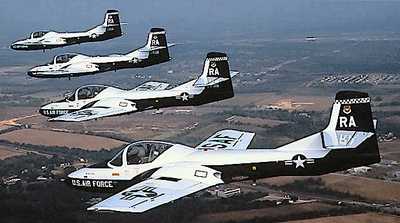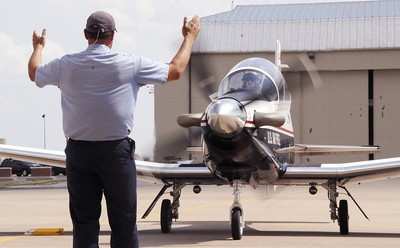The T-37 Tweet (pictured below) officially began its march
toward full retirement March 31 when 80th Flying Training Wing
officials at Sheppard Air Force Base "took the car keys" to its
replacement, the T-6A Texan II. Retired Navy Rear Adm. James
Maslowski, the vice president of government business for Hawker
Beechcraft in Wichita, Kan., presented Col. David Petersen, the
80th FTW commander, with a set of keys, a ceremonial gesture
signifying the wing's acceptance of the first two trainers.

"We are pleased that you are beginning training in the T-6, but
it also marks the end of a historical aircraft, the T-37," Admiral
Maslowski said. Sheppard Air Force Base currently has eight T-6As
(shown below) on its ramp, but will receive a total of 69 over the
next 18 months. Base officials have 74 T-37s at this time.
The two aircraft taxied up to a vintage AT-6 Texan a little
after 3 p.m. Colonel Petersen piloted the first aircraft, with
Euro-NATO Joint Jet Pilot Steering Committee Chairman Royal
Netherlands Air Force Air Commodore Peter Berlijn in the back seat.
The second T-6A was piloted by Capt. Brian Wood, an instructor
pilot at the 89th Flying Training Squadron. Italian Brig. Gen.
Franco Marsiglia, the steering committee's incoming chairman, was
also in the second aircraft.
The T-37 began service in the Air Force in 1956, but didn't
arrive at Sheppard AFB until 1966. It's been the primary
introductory pilot training aircraft since. The more than
50-year-old aircraft, while reliable, has antiquated avionics that
doesn't provide a realistic approach for today's undergraduate
pilot trainees.

"The avionics of the T-37, all the instrumentation, is from that
era," Colonel Petersen said. "We've made great advancements in how
we do our instrument flying and this airplane (the T-6A) is really
laid out like future cockpits would be."
The colonel said the tandem -- or front seat, back seat --
configuration and advanced instrumentation provides for an easy
transition into the advanced pilot training aircraft, the T-38C
Talon. Another plus for pilot trainees in Euro-NATO Joint Jet Pilot
Training is the ability to "fly" numerous times before touching the
aircraft. The advancement of flight simulation technologies
provides realistic situations for student pilots in a controlled
environment.
Air Commodore Berlijn said although the introduction of the T-6A
into the program was primarily a decision by the U.S. Air Force,
NATO countries participating in the program will benefit from the
new training aircraft. The T-6A is an important milestone because
it shows Euro-NATO Joint Jet Pilot Training is "very healthy" and a
"very good program," he said. "It's very much alive. It's very
healthy, and it will be healthy in the future with great assistance
like the T-6A."

The T-6A was named the Texan because it was built in Grand
Prairie, Texas. Like the Texan II, the original Texan was used as a
primary trainer, but in the area of aerial combat maneuvers.
Sheppard AFB officials received two Texan II aircraft in January to
begin training Lier Siegler Services, Inc., maintainers. Instructor
pilots at the wing are currently training on the aircraft and
students should begin flying it in the fall. [ANN Salutes John
Ingle, 80th Flying Training Wing Public Affairs]
 ANN's Daily Aero-Linx (04.13.24)
ANN's Daily Aero-Linx (04.13.24) ANN's Daily Aero-Term (04.13.24): Beyond Visual Line Of Sight (BVLOS)
ANN's Daily Aero-Term (04.13.24): Beyond Visual Line Of Sight (BVLOS) Airborne 04.09.24: SnF24!, Piper-DeltaHawk!, Fisher Update, Junkers
Airborne 04.09.24: SnF24!, Piper-DeltaHawk!, Fisher Update, Junkers Aero-News: Quote of the Day (04.14.24)
Aero-News: Quote of the Day (04.14.24) ANN's Daily Aero-Term (04.14.24): Maximum Authorized Altitude
ANN's Daily Aero-Term (04.14.24): Maximum Authorized Altitude





